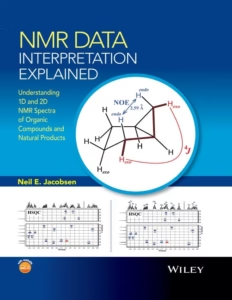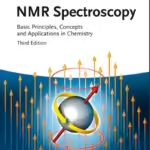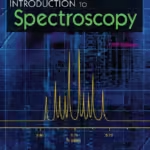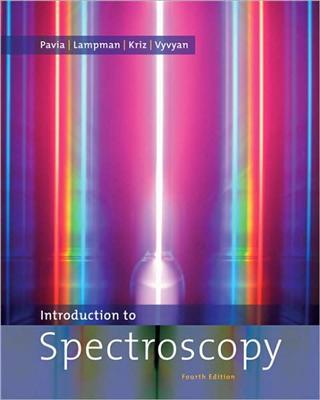 Free download NMR Data Interpretation Explained: Understanding 1D and 2D NMR Spectra of Organic Compounds and Natural Products by Neil E. Jacobsen in pdf.
Free download NMR Data Interpretation Explained: Understanding 1D and 2D NMR Spectra of Organic Compounds and Natural Products by Neil E. Jacobsen in pdf.
Nuclear magnetic resonance (NMR) spectroscopy is a technique used to determine the structure of molecules at the level of individual atoms and covalent bonds. While it does not provide a direct picture or image of the molecule, the NMR data can be interpreted to determine which atoms in a molecule are connected to which atoms, and whether these bonds connecting them are single, double, or triple bonds.
Further information can be obtained from this data about the distances between atoms that are not bonded, and the angles between bonds, leading to a complete three-dimensional model of the molecule.
The field of NMR can be divided into three categories: imaging (MRI), solid-state NMR, and solution-state (liquids) NMR. NMR imaging is familiar to anyone who has gone to a hospital or clinic for an MRI “scan,” which yields a picture of “slices” through the human body that is extremely useful in medical diagnosis.
Solid-state NMR is the analysis of solid materials, usually ground into a powder; this is applied primarily to the analysis of materials such as polymers, but it can also be applied to biological membranes. Solution-state NMR looks at molecules dissolved in a solvent, which can be water or an organic solvent such as acetone or chloroform.
This book is focused on solution-state NMR, the primary tool used by organic chemists and biochemists to determine molecular structure.
A further distinction is made between “small molecules” and “large molecules” in solution. In the context of solution-state NMR, a large molecule is a biological molecule such as a protein or nucleic acid, made up of many repeating units that all have similar structures.
A small molecule has a molecular weight less than 1000 Da and is usually made up of diverse structural elements (carbon chains, rings, and functional groups) rather than a repeating pattern. Small molecules are the domain of the organic chemist: natural products, drugs, and the intermediates and products of organic synthesis. Also included in this category are the short chains of biological molecules: peptides, oligonucleotides, and oligosaccharides (sugars).
This book will focus on the use of NMR data to determine the covalent structure (which atoms are connected to which atoms) and three-dimensional shape (stereochemistry and conformation) of these small molecules.
This book is different from most books on NMR because it is focused on examples and exercises. Each topic is introduced with one of more examples of NMR data with detailed explanations of the interpretation of that data.
Examples are then followed by a number of exercises using detailed images of NMR data, and these are followed by solutions, again with detailed explanation of the step-by-step reasoning used to solve the exercise.
The title, NMR Data Interpretation Explained, is an indication of this focus on example and explanation. Every detail and aspect of the NMR data is explained, not just the simple and beautiful spectra but also the complex and surprising spectra.
Contents
- Spectroscopy and the Proton NMR Experiment
- Chemical Shifts and Splitting Patterns
- Proton (1H) NMR of Aromatic Compounds
- Carbon-13 (13C) NMR
- Alkenes (Olefins)
- Chirality and Stereochemistry: Natural Products
- Selective Proton Experiments: Biological Molecules
- Homonuclear Two-Dimensional NMR: Correlation of One Hydrogen (1H) to Another
- Heteronuclear Two-Dimensional NMR: Correlation of One Hydrogen (1H) to One Carbon (13C)
- Structure Elucidation Using 2D NMR
Free download NMR Data Interpretation Explained: Understanding 1D and 2D NMR Spectra of Organic Compounds and Natural Products by Neil E. Jacobsen in pdf from following download links.
To access the download links, please follow these instructions. If the links do not appear on your mobile device, try visiting this page using a laptop or desktop computer for better visibility.
Password for Download Links: chemistry.com.pk
File Size: 20.2 MB. Pages: 651. Download Instructions. Please read Disclaimer.
You can also buy NMR Data Interpretation Explained: Understanding 1D and 2D NMR Spectra of Organic Compounds and Natural Products by Neil E. Jacobsen from Amazon by clicking the image below.

You may also like to download the following books for free:
- Spectroscopic Methods in Organic Chemistry (3rd Ed.) by Stefan Bienz, Laurent Bigler, Thomas Fox & Herbert Meier
- NMR and Chemistry – An Introduction to Modern NMR Spectroscopy (4th Edition) By J. W. Akitt and B. E. Mann
- NMR Spectroscopy: Basic Principles, Concepts and Applications in Chemistry (3rd Ed.) By Harald Günther
Free Download Hundreds of Best-Selling Biology and Chemistry Books from Download Biology and Chemistry Books.
P.S: If the download link(s) is/are not working, kindly drop a comment below, so we’ll update the download link for you.
Happy studying!


